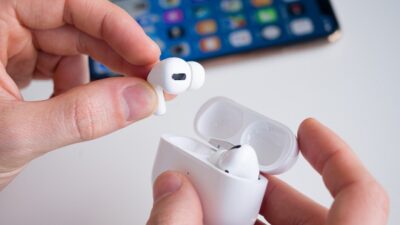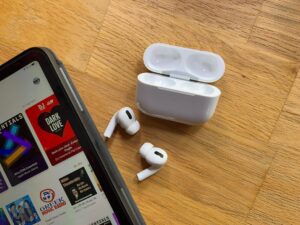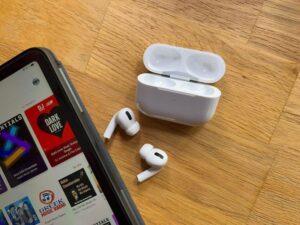Have you ever put on your AirPods and noticed that one earbud is significantly louder than the other? It can be a frustrating experience, especially when you’re trying to enjoy your favorite music or podcast. But why is one airpod louder than the other?
If you’ve ever experienced the annoyance of one AirPod being louder than the other, you’re not alone. In this article, we will explore the common reasons why one AirPod may be louder than the other and provide some solutions to fix this issue.
Causes of one AirPod being louder than the other?
Uneven sound delivery between the two AirPods can be a frustrating issue for users. There are several potential causes for this problem, which we will explore below.
-
Manufacturing Defects:
One possible cause of unequal sound between the AirPods is a manufacturing defect. This can result in one AirPod having a weaker speaker than the other, which can cause the sound to be quieter on one side. If this is the case, the only solution is to contact Apple support and arrange for a replacement.
-
Blockage of the Sound Vents:
Another potential cause of uneven sound delivery is blockage of the sound vents. These vents are small openings on the outside of the AirPods that allow sound to pass through. If these vents become clogged with dirt, dust, or other debris, it can affect the sound quality of one or both AirPods. To fix this issue, users can gently clean the vents with a soft-bristled brush or a cotton swab.
-
Accumulation of Debris in the Sound Mesh:
Similar to the sound vents, the sound mesh on the AirPods can become clogged with debris over time. This can affect the sound quality and cause one AirPod to be louder than the other. To clean the sound mesh, users can use a soft-bristled brush or a cotton swab. It’s important to be gentle when cleaning the mesh to avoid damaging the delicate components inside the AirPods.
-
Earwax Build-up in the Mesh:
Earwax is a common cause of uneven sound between the AirPods. Over time, earwax can build up on the sound mesh, which can affect the sound quality of one or both AirPods. To clean the sound mesh, users can use a soft-bristled brush or a cotton swab. Alternatively, they can use a specialized cleaning tool designed specifically for AirPods.
-
Disconnection or Interference of the Bluetooth Signal:
Sometimes, the issue of uneven sound delivery can be due to a weak or intermittent Bluetooth signal. If the signal is weak, it can cause one AirPod to be louder than the other. To fix this issue, users should try moving closer to the device they are connected to or resetting the AirPods by putting them back in their case for a few seconds before reconnecting them.
-
Battery Drainage:
Another potential cause of uneven sound delivery is battery drainage. If one AirPod has a low battery, it may produce a quieter sound than the other. To fix this issue, users should charge both AirPods fully before using them.
-
Software Updates and Bugs:
Finally, uneven sound delivery can be caused by software updates or bugs. If this is the case, users should check for any available updates and install them if necessary. If the issue persists, they should contact Apple support for assistance.
How to fix imbalanced AirPods sound?
If you are experiencing imbalanced sound between your AirPods, there are several steps you can take to try to fix the issue. Here are some troubleshooting tips:
- Clean your AirPods: As mentioned earlier, blockages or buildup of debris can cause imbalanced sound. Use a soft-bristled brush or a cotton swab to gently clean the sound vents and mesh of your AirPods.
- Reset your AirPods: Try resetting your AirPods by placing them in their charging case and holding down the button on the back of the case until the LED light flashes. Then, reconnect your AirPods to your device and see if the sound has improved.
- Check for software updates: Ensure that both your AirPods and the device they are connected to have the latest software updates. This can help resolve any bugs or software-related issues that could be causing imbalanced sound.
- Adjust the audio balance: You can manually adjust the audio balance between your AirPods on your device’s settings. Go to Settings > Accessibility > Audio/Visual > Balance and slide the audio balance control to the middle.
- Try a different device: Test your AirPods with a different device to see if the imbalanced sound persists. If it does not, then the issue may be with your original device, and you should check its audio settings or contact the manufacturer for assistance.
- Contact Apple Support: If none of the above steps have resolved the issue, contact Apple Support for further assistance. They may be able to diagnose and resolve the problem or arrange for a replacement if necessary.
By following these steps, you can troubleshoot and potentially fix imbalanced sound between your AirPods, allowing you to enjoy your audio content with a clear and balanced sound.
How to reset and recalibrate AirPods?
Resetting and recalibrating your AirPods can be helpful if you are experiencing issues such as imbalanced sound, connection problems, or other performance issues. Here’s how to do it:
- Reset your AirPods: Place both AirPods into their charging case and keep the lid open. Press and hold the button on the back of the case until the LED light on the front starts flashing amber. After a few seconds, the light should turn white, indicating that your AirPods have been reset.
- Recalibrate your AirPods: Once your AirPods have been reset, it’s a good idea to recalibrate them to ensure that they are working together properly. To do this, put both AirPods in your ears and play music or another audio source. Then, go to Settings > Bluetooth on your device and tap the “i” icon next to your AirPods. Tap “Forget This Device” and then confirm the action. After forgetting your AirPods, pair them again with your device and play some audio to see if the issue has been resolved.
Note: It’s important to clean your AirPods before recalibrating them to ensure that any blockages or debris are removed. Also, recalibration may not be necessary in all cases, so resetting your AirPods may be enough to resolve some issues.
By resetting and recalibrating your AirPods, you can troubleshoot and potentially fix issues with their performance, including imbalanced sound and connection problems. If you continue to experience issues after resetting and recalibrating your AirPods, contact Apple Support for further assistance.
Does cleaning AirPods help?
Yes, cleaning your AirPods can help improve their performance and sound quality. Over time, dirt, debris, and earwax can accumulate on the AirPods’ mesh screens, blocking the sound vents and leading to muffled or imbalanced sound.
Cleaning your AirPods is easy and can be done with a soft-bristled brush, a microfiber cloth, or a cotton swab. Here are the steps to follow:
- Remove the ear tips: Gently pull the ear tips off your AirPods and set them aside.
- Brush away debris: Use a soft-bristled brush or a microfiber cloth to brush away any visible dirt or debris on the AirPods and their charging case. Be careful not to damage the mesh screens.
- Clean the mesh screens: Use a cotton swab dipped in rubbing alcohol or water to clean the mesh screens on your AirPods. Be gentle, and don’t apply too much pressure. Make sure the mesh screens are completely dry before using your AirPods again.
- Reattach the ear tips: Once the AirPods are dry, reattach the ear tips and make sure they fit securely.
Regular cleaning of your AirPods can help prevent the accumulation of dirt and debris that can impact their performance. It’s recommended to clean your AirPods at least once a week or more often if you use them frequently or in dirty or dusty environments.
What is the difference between noise canceling and transparency mode in airpods?
AirPods Pro and some models of AirPods Max have two listening modes: noise canceling and transparency mode.
Noise-canceling mode
This uses advanced algorithms to cancel out external noise and deliver immersive, high-quality sound. It blocks out background noise so you can focus on your audio content without distractions.
This mode is ideal for use in noisy environments such as airplanes, trains, or busy city streets. It works by using external microphones to detect the level of ambient noise and then generates an equal and opposite sound wave to cancel it out.
Transparency mode
This mode uses external microphones to pick up the sounds around you and then plays them through the AirPods, creating a natural and balanced audio experience. It’s great for when you need to be aware of your surroundings, such as when crossing a street or having a conversation with someone.
Switching between these two modes is easy and can be done directly from your AirPods or from your device’s control center. With AirPods Pro, you can also switch between noise canceling and transparency modes using the force sensor on the stem of the earbuds.
Generally, noise canceling mode blocks out external noise, while transparency mode allows you to hear your surroundings. Both modes provide unique listening experiences that can be useful in different situations.
What is the warranty for AirPods sound issues?
If you’re experiencing sound issues with your AirPods, it’s important to know what kind of warranty coverage you have. Here’s what you need to know:
- Limited Warranty: All AirPods come with a limited one-year warranty from the date of purchase. This warranty covers manufacturing defects and hardware malfunctions but does not cover accidental damage, normal wear, and tear, or damage caused by unauthorized repairs or modifications.
- AppleCare+: If you purchase AppleCare+ for your AirPods, you can extend your warranty coverage to two years from the date of purchase. This plan covers up to two incidents of accidental damage but does not cover the loss or theft of your AirPods. AppleCare+ also provides 24/7 priority access to Apple support for troubleshooting and repairs.
If you’re experiencing sound issues with your AirPods within the warranty period, you may be eligible for a repair or replacement at no cost. To initiate a warranty claim, contact Apple support and explain the issue you’re experiencing.
They may ask you to perform some troubleshooting steps or provide diagnostic information to help determine the cause of the problem. If the issue cannot be resolved through troubleshooting, they may authorize a repair or replacement of your AirPods.
Can you replace imbalanced AirPods?
Yes, if you’re experiencing imbalanced sound between your AirPods and cleaning them doesn’t solve the issue, you may be able to replace the affected AirPod. Here are the steps to follow:
- Check your warranty: If your AirPods are still under warranty, contact Apple support to explore your options for repair or replacement. If the issue is due to a manufacturing defect, you may be eligible for a free replacement.
- Purchase a replacement AirPod: If your AirPods are no longer under warranty or the issue is not covered by the warranty, you can purchase a replacement AirPod from Apple. You’ll need to ensure that the replacement AirPod is compatible with your existing AirPods model (i.e., AirPods Pro, AirPods 2nd Generation, etc.).
- Pair the new AirPod: Once you have the replacement AirPod, you’ll need to pair it with your existing AirPods. To do this, place both AirPods in their charging case and hold the button on the back of the case until the LED light flashes. Then, open the lid of the charging case and hold the new AirPod near the existing one. Follow the on-screen prompts on your device to complete the pairing process.
If you’re still experiencing imbalanced sound after replacing one of your AirPods, it’s possible that the issue is with the charging case or your device’s settings. Try resetting your AirPods and recalibrating them to see if that helps. If you’re still having issues, contact Apple support for further assistance.
Troubleshooting tips for AirPods sound imbalance
If you’re experiencing a sound imbalance between your AirPods, there are several troubleshooting tips you can try:
- Clean your AirPods: Debris or earwax buildup on the AirPods or inside the charging case can cause sound imbalance. Use a soft, dry, and lint-free cloth to gently clean the AirPods and the charging case. Avoid using water or any liquid cleaners.
- Check the sound balance settings: Make sure that the sound balance settings on your device are not causing the imbalance. Check the balance slider in your device’s settings and adjust it to the center position.
- Reset your AirPods: Try resetting your AirPods by placing them in their charging case and holding down the button on the back of the case until the LED light flashes. Then, pair your AirPods with your device again to see if the imbalance is resolved.
- Recalibrate your AirPods: If resetting your AirPods doesn’t work, you can try recalibrating them. Play some music or other audio content and place both AirPods in your ears. Open the Settings app on your device, go to Bluetooth, and find your AirPods in the list of available devices. Tap the “i” icon next to your AirPods and select “Forget This Device.” Then, re-pair your AirPods with your device.
- Check the fit of your AirPods: If your AirPods are not sitting properly in your ears, they may not deliver balanced sound. Try adjusting the position of your AirPods in your ears, or try using different size ear tips.
- Contact Apple support: If you’ve tried these troubleshooting tips and still experience sound imbalance, contact Apple support for further assistance. They may be able to diagnose the issue and provide a solution, including a repair or replacement if necessary.
Additionally, cleaning your AirPods, checking sound balance settings, resetting and recalibrating your AirPods, checking the fit, and contacting Apple support are all potential solutions for sound imbalance issues.
Conclusion
Are you curious about why is one airpod louder than the other? We have got you covered here. There are several reasons why one AirPod may be louder than the other, including manufacturing defects, blockages or accumulation of debris, earwax build-up, Bluetooth signal issues, battery drainage, and software bugs.
It’s important to try troubleshooting steps such as cleaning the AirPods, resetting or recalibrating them, and checking the sound balance settings before seeking further assistance from Apple support. In some cases, it may be possible to replace the affected AirPod if the issue cannot be resolved through troubleshooting.




